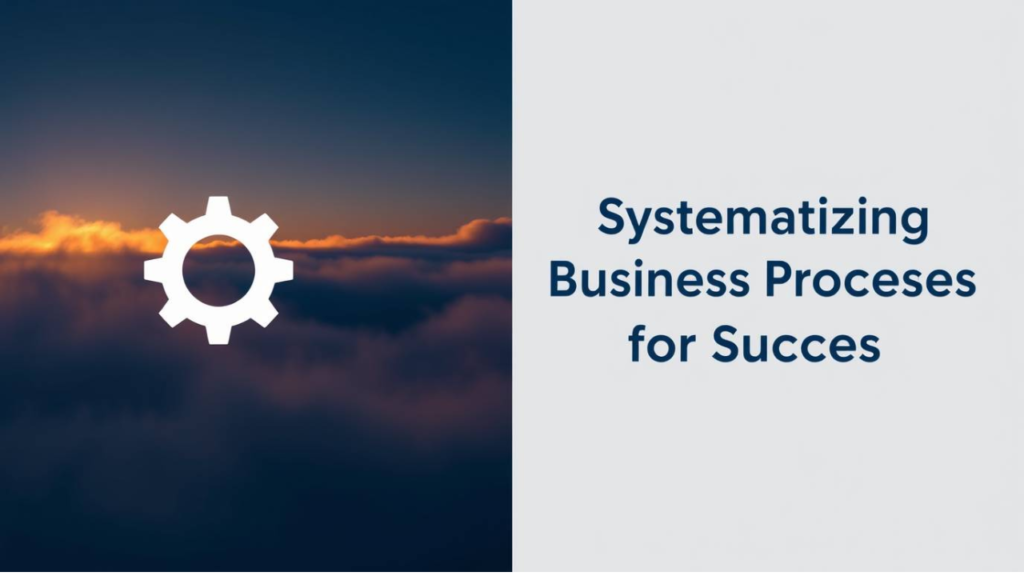Effective business processes are the backbone of operational efficiency. Streamlining tasks with proper tools, templates, and a systematization philosophy can significantly enhance productivity, minimize errors, and help businesses scale effectively. In this article, we will explore strategies for systematizing business processes, covering everything from the importance of templates to tool recommendations and efficient hiring practices.

1. Templates and Checklists: The Backbone of Consistency
A well-structured business process relies on templates and checklists, which provide consistency and simplify task management. Reusable folders and templates ensure that each project starts with a consistent foundation, eliminating the need to reinvent the wheel for every new task.
Why It Matters: Templates are particularly valuable for tasks that are repetitive, such as publishing content, onboarding new employees, or running production cycles. By developing Standard Operating Procedures (SOPs) for these repetitive tasks, businesses can ensure that everyone follows the same steps, reducing errors and maintaining quality. These SOPs create a clear, repeatable system for accomplishing essential tasks, making it easier for employees to stay aligned with business goals.
Actionable Tip: Set up template folders within your file management system, so your team can easily access the necessary files for each project. Ensure that SOPs are clear, easy to follow, and accessible to everyone involved in the process.
2. Systemization Philosophy: Striking the Right Balance
Systematizing your business processes is more than just organizing tasks—it’s about finding the right balance between documentation and efficiency. While clear documentation is crucial, over-documentation can waste time and resources that could otherwise be spent on actual work.
Key Considerations:
Efficiency Over Excess: Overloading your team with excessive documentation can lead to delays and unnecessary complexity. Instead, focus on what’s essential, such as clear workflows, critical checkpoints, and easy-to-understand guidelines.
Tailor Systemization to Your Business Needs: The degree of systemization will vary depending on your company’s size and goals. A large enterprise might need a more formalized system, while a small team might function more efficiently with simpler processes. Customizing the system to fit your business needs is key to maintaining flexibility and efficiency.
Actionable Tip: Determine which processes truly require detailed documentation and which can be simplified. Regularly assess and adjust your documentation practices to ensure they remain aligned with the evolving needs of your business.
3. Tool Recommendations: Streamline with the Right Software
To effectively manage systematized processes, using the right tools is essential. Centralized work management software like ClickUp or SmartSuite can help organize, track, and share documents such as templates, SOPs, and task lists. These platforms provide a central hub where all team members can access the necessary materials to execute their tasks efficiently.
Why These Tools Work:
Collaboration in Real-Time: Centralized tools facilitate team collaboration and real-time updates, allowing everyone to stay on the same page.
Simplify Tracking and Accountability: These tools allow for task tracking, providing clear visibility of who is responsible for each step in the process and when it is due.
Automate Repetitive Tasks: Many of these platforms offer automation features that can handle routine tasks, reducing the need for manual input and freeing up time for more critical work.
Actionable Tip: Invest time in selecting a work management tool that aligns with your team’s needs. Set up your workflows, templates, and SOPs within the tool to create a centralized, streamlined environment for everyone.
4. Hiring Without Full Systemization: Building the Framework
Systematizing your processes doesn’t always mean you need a fully established system before bringing on new hires. However, it’s important to define deliverables and ensure that new hires are trained in how to contribute to the creation of processes.
Strategic Approach:
Define Deliverables: Even in a relatively unstructured environment, clearly define what you expect from new hires. This ensures they know their responsibilities and understand the direction of their work.
Leverage Team Expertise: Use the experience and expertise of your current team members to fill in the gaps. As your processes evolve, newer hires can participate in defining “how” tasks are done, helping to refine the process over time.
Actionable Tip: Create a training program for new hires that includes process creation, focusing on how they can contribute to and enhance the existing workflows. Regularly gather input from employees to ensure that processes are always improving.
5. Responsibility Assignment: Go Beyond Traditional Role Charts
Traditional role charts typically offer a static overview of responsibilities, but dynamic tools like task assignees in project management software provide greater flexibility. This allows your team to quickly adjust to changing workloads, and helps individuals focus on their strengths while contributing to a broader team effort.
Dynamic Responsibility Assignment: Instead of assigning rigid roles to individuals, let team members take ownership of tasks on a project basis. As tasks change or grow, team members can dynamically take on new responsibilities based on their expertise and availability.
Actionable Tip: Utilize project management tools to assign tasks, ensuring that each team member knows exactly what is expected. This can help adapt quickly to changing needs without the need for a rigid hierarchy.
Conclusion:
Systematizing business processes is key to achieving efficiency and growth. By using templates, choosing the right tools, defining responsibilities, and adapting your approach to systematization, you can improve consistency while avoiding unnecessary bureaucracy. These strategies, when implemented correctly, will streamline your operations and position your business for greater success.

